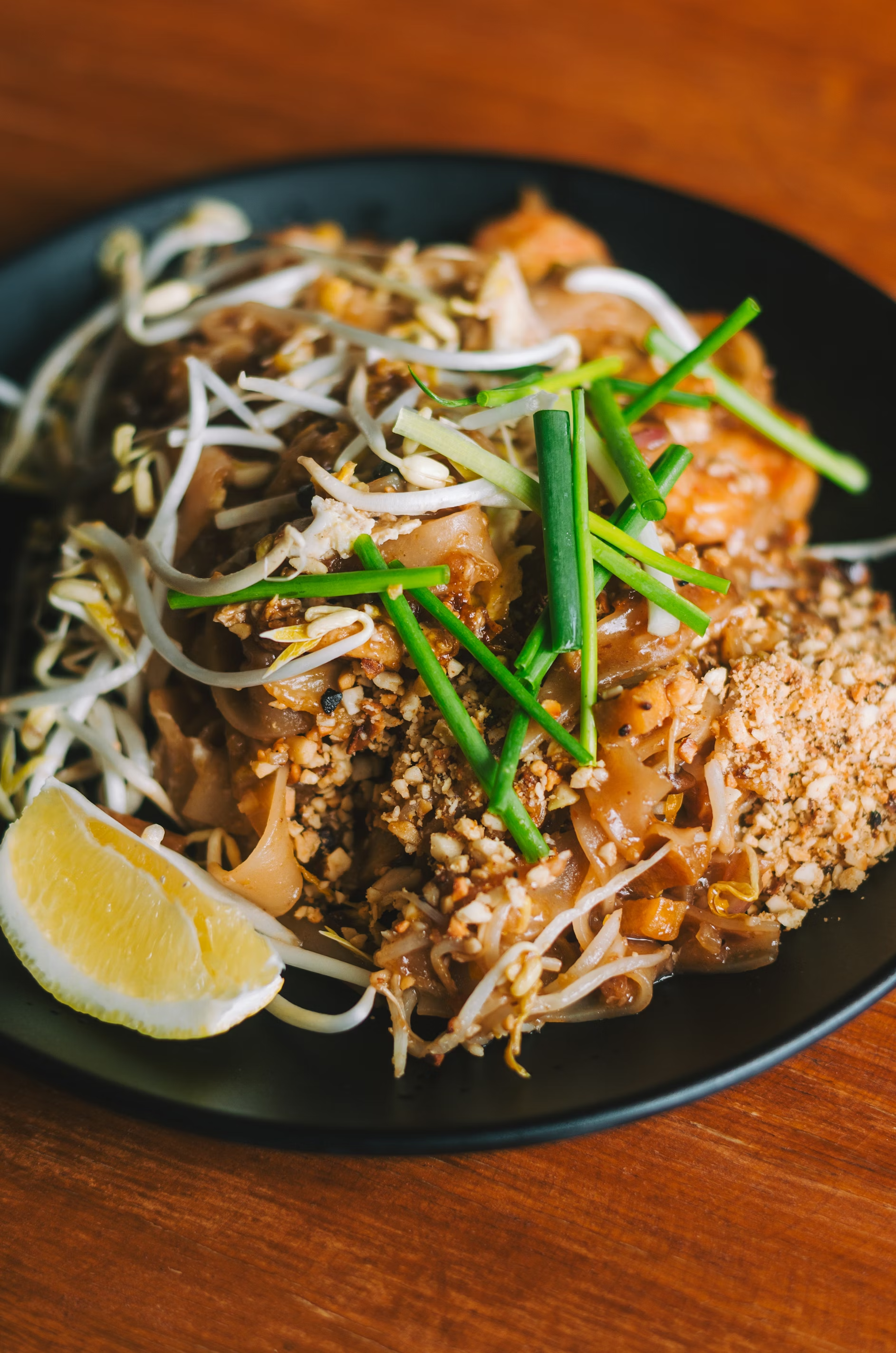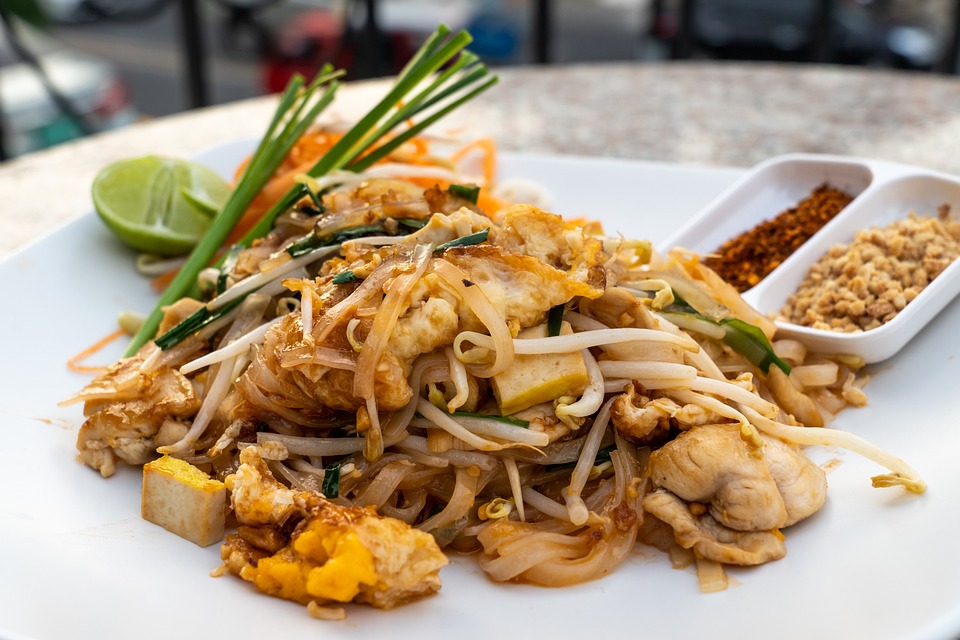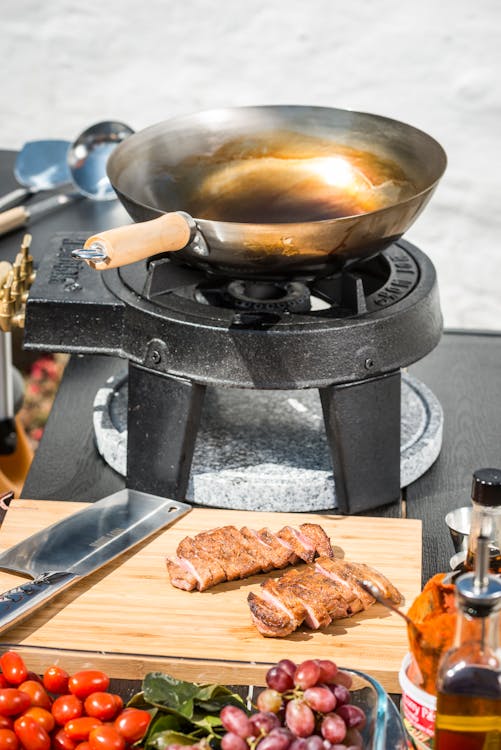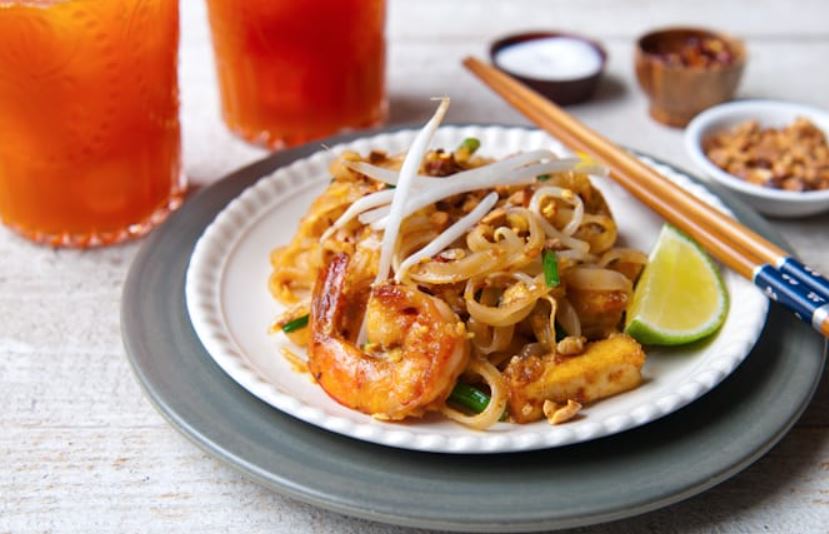Best Tasting Pad Thai
Pad Thai, a quintessential dish in Thai cuisine, has a fascinating history that intertwines with Thailand's cultural and political landscape. Its origins date back to the mid-20th century, during a period of national modernization and identity formation.
Pad Thai is traditionally made with rice noodles, a protein such as shrimp or chicken, eggs, tofu, bean sprouts, and a tangy-sweet sauce made from tamarind paste, fish sauce, and palm sugar. The dish is often garnished with chopped peanuts, fresh cilantro, lime wedges, and sometimes red chili flakes for an extra kick.

Ingredients
Rice Noodles:
- 200g rice noodles
Sauce:
- 3 tablespoons fish sauce
- 1 tablespoon soy sauce
- 2 tablespoons tamarind paste
- 3 tablespoons palm sugar or brown sugar
- 1 tablespoon lime juice
Protein and Vegetables:
- 200g shrimp (peeled and deveined) or chicken breast (thinly sliced)
- 2 eggs
- 2 cloves garlic (minced)
- 1 shallot (finely chopped)
- 1 cup bean sprouts
- 1/2 cup firm tofu (cubed)
- 1/4 cup roasted peanuts (chopped)
- 2 green onions (chopped)
- 1 carrot (julienned)
Garnishes:
- Fresh cilantro (chopped)
- Lime wedges
- Red chili flakes (optional)

How To Make Pad Thai Sauce
Instructions
Prepare the Ingredients:
- Measure out the fish sauce, soy sauce, tamarind paste, palm sugar (or brown sugar), and lime juice.
Combine Ingredients:
- In a small bowl, combine the fish sauce, soy sauce, tamarind paste, and palm sugar.
Heat the Mixture:
- Heat a small saucepan over low heat.
- Pour the combined ingredients into the saucepan and gently heat it, stirring continuously to help the sugar dissolve and the ingredients meld together. This should take about 2-3 minutes. Be careful not to let the mixture boil.
Add Lime Juice:
- Remove the saucepan from the heat.
- Add the lime juice to the mixture and stir to combine.
Taste and Adjust:
- Taste the sauce and adjust the flavors as needed. If it’s too salty, add a bit more sugar. If it’s too sweet, add a bit more lime juice or tamarind paste.
Cool and Store:
- Allow the sauce to cool. You can use it immediately or store it in an airtight container in the refrigerator for up to a week.
Tips for Making Perfect Pad Thai Sauce
- Balance the Flavors: The key to a great Pad Thai sauce is balancing the salty (fish sauce), sweet (palm sugar), sour (tamarind paste and lime juice), and umami (soy sauce) flavors. Adjust each ingredient to your taste.
- Use Authentic Ingredients: Using authentic ingredients like tamarind paste and fish sauce will give your Pad Thai an authentic taste. If you can’t find these, you can substitute with similar ingredients, but the flavor might vary.
- Make Ahead: You can make the sauce ahead of time and store it in the refrigerator, making it convenient for quick meals.

Method
- Prepare the Noodles:
- Soak the rice noodles in warm water for about 30 minutes or until they are pliable. Drain and set aside.
- Make the Sauce:
- See above
- Cook the Protein:
- Heat a tablespoon of oil in a large skillet or wok over medium-high heat. Add the shrimp or chicken and cook until they are just done. Remove from the pan and set aside.
- Cook the Aromatics:
- In the same pan, add a bit more oil if needed. Sauté the garlic and shallot until fragrant, about 1 minute.
- Cook the Tofu:
- Add the tofu to the pan and cook until golden brown on all sides.
- Scramble the Eggs:
- Push the tofu to one side of the pan and crack the eggs into the other side. Scramble the eggs until just set, then mix everything together.
- Add the Noodles:
- Add the soaked and drained noodles to the pan. Pour the sauce over the noodles and toss to combine. Cook for about 2-3 minutes until the noodles are tender and well-coated with the sauce.
- Combine Everything:
- Add the cooked shrimp or chicken back to the pan, along with the bean sprouts, green onions, and carrots. Toss everything together and cook for another 2 minutes until heated through.
- Serve:
- Transfer the Pad Thai to serving plates. Garnish with chopped peanuts, fresh cilantro, lime wedges, and red chili flakes if desired.
Shopping List
- Rice Noodles: 200g rice noodles
- Sauce Ingredients:
- Fish sauce
- Soy sauce
- Tamarind paste
- Palm sugar or brown sugar
- Lime juice (or fresh limes)
- Protein and Vegetables:
- 200g shrimp (peeled and deveined) or chicken breast
- 2 eggs
- Garlic (2 cloves)
- Shallot (1)
- Bean sprouts (1 cup)
- Firm tofu (1/2 cup, cubed)
- Roasted peanuts (1/4 cup, chopped)
- Green onions (2)
- Carrot (1)
- Garnishes:
- Fresh cilantro
- Lime wedges
- Red chili flakes (optional)

Tips for Perfect Pad Thai
- Noodle Soaking: Soak the noodles until they are pliable but not mushy. This usually takes around 30 minutes in warm water.
- Balance the Sauce: Taste the sauce before adding it to the noodles. Adjust the sweetness, saltiness, or tanginess by adding more sugar, fish sauce, or lime juice as needed.
- Stir-Frying: Cook the ingredients quickly over high heat to retain their crunch and texture. Stir constantly to prevent sticking.
- Garnishes: Fresh garnishes like cilantro and lime juice add a bright, fresh flavor to the dish. Don’t skip them!
Tools and utensils needed for Pad Thai
Saucepan: For soaking or cooking the noodles.
Knife: A sharp knife for chopping and slicing ingredients such as vegetables, tofu, and proteins.
Cutting Board: A sturdy surface for preparing ingredients.
Mixing Bowls: Various sizes for mixing the sauce and holding prepped ingredients.
Measuring Spoons: For accurately measuring sauce ingredients.
Measuring Cups: For measuring larger quantities of ingredients like noodles and vegetables.
Tongs or Spatula: For stirring and tossing the noodles and other ingredients in the skillet or wok.
Colander or Strainer: For draining soaked or cooked noodles.
Grater or Zester: Useful if you need to zest lime for added flavor.
Vegetable Peeler: For peeling vegetables, especially if you’re using carrots.
Spiralizer (optional): If making low-carb Pad Thai with zucchini noodles, a spiralizer is necessary to create the noodles.
Serving Plates or Bowls: For presenting the finished Pad Thai.
Chopsticks or Forks: For eating and enjoying your Pad Thai.

Here are five different variations of Pad Thai, each with its unique twist:
Classic Pad Thai:
- Ingredients: Rice noodles, shrimp or chicken, tofu, eggs, bean sprouts, green onions, crushed peanuts, lime, tamarind paste, fish sauce, palm sugar, garlic, red chili flakes.
- Description: The traditional version of Pad Thai, often found in street markets and restaurants in Thailand. It's a balanced mix of sweet, sour, salty, and umami flavors.
Vegan Pad Thai:
- Ingredients: Rice noodles, tofu, bean sprouts, green onions, crushed peanuts, lime, tamarind paste, soy sauce (or tamari for gluten-free), palm sugar, garlic, red chili flakes, vegetables like bell peppers, carrots, and snap peas.
- Description: A plant-based version that omits animal products and uses tofu for protein. It's equally flavorful and satisfying, catering to vegan diets.
Seafood Pad Thai:
- Ingredients: Rice noodles, mixed seafood (shrimp, squid, scallops), eggs, bean sprouts, green onions, crushed peanuts, lime, tamarind paste, fish sauce, palm sugar, garlic, red chili flakes.
- Description: A variation that highlights a variety of seafood, providing a rich, briny flavor. This version is popular in coastal regions where fresh seafood is abundant.
Chicken and Pineapple Pad Thai:
- Ingredients: Rice noodles, chicken breast, pineapple chunks, eggs, bean sprouts, green onions, crushed peanuts, lime, tamarind paste, fish sauce, palm sugar, garlic, red chili flakes.
- Description: Adds a tropical twist with sweet and tangy pineapple, complementing the savory chicken and traditional Pad Thai flavors. This version offers a unique taste experience.
Pad Thai with Peanut Sauce:
- Ingredients: Rice noodles, shrimp or chicken, tofu, eggs, bean sprouts, green onions, crushed peanuts, lime, tamarind paste, fish sauce, palm sugar, garlic, red chili flakes, creamy peanut butter or homemade peanut sauce.
- Description: Enhances the nutty flavor by incorporating a rich, creamy peanut sauce. This variation is perfect for peanut lovers, offering a creamy texture and deeper nutty taste.
Each of these variations maintains the essence of Pad Thai while introducing different ingredients and flavors to create a unique culinary experience.
